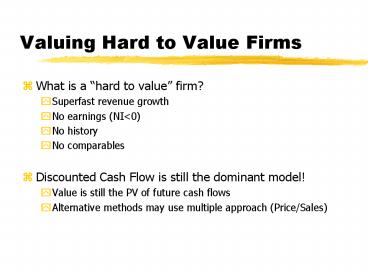Valuing Hard to Value Firms PowerPoint PPT Presentation
1 / 12
Title: Valuing Hard to Value Firms
1
Valuing Hard to Value Firms
- What is a hard to value firm?
- Superfast revenue growth
- No earnings (NI
- No history
- No comparables
- Discounted Cash Flow is still the dominant model!
- Value is still the PV of future cash flows
- Alternative methods may use multiple approach
(Price/Sales)
2
Measuring Cash Flow 2 common measures
- FCFF EBIT(1-t) - (Capital Expenditures -
Depreciation Expense) - Change in Working Capital - gFCFF RR x Return on Capital
- Value of Firm FCFF1/(WACC - gFCFF)
- Value of Equity Value of Firm - Value of Debt
- FCFE NI - (Capital Expenditures - Depreciation
Expense) - Change in Working Capital - Change in
Debt - gFCFE RR x Return on Equity
- Value of Equity FCFE1/(k - gFCFE)
3
Problems Negative Earnings
- Cant estimate growth from current earnings!
- Possible Solution? Normalize Earnings
- Are earnings normally positive?
- Firm had a bad year
- Cyclical firm during a recession
- How long with this last?
- Average firms earnings over prior periods
- Average firms ROC, ROE, or profit margins over
prior periods - Use ROC, ROE, or margins for comparable firms
4
Problems No History, No Comparables
- No History? Use contemporaneous data form
comparable firms - This is how software firms get valued at IPO
- What are comparables?
- Similar business
- quality of information
- industry life cycle
- No Comparables? Use history!
5
The Big Problem No Earnings, No History, No
Comparables
- Stay focused on Discounted Cash Flows!
- 1. Get the most recent financial info (TTM)
- 2. Estimate expected revenue growth
- past growth of firms revenues
- growth rate for overall market firm services
- recognize barriers to entry, competitive
advantages - 3. Estimate sustainable operating margin
- what will operating margin look like when revenue
growth stabilizes?
6
The Big Problem No Earnings, No History, No
Comparables
- 4. Reinvestment needs
- RR gEBIT x ROC
- assume net Cap. Expense and change in WC will
grow with revenue or that revenue growth lags
reinvestment. - 5. Risk Parameters and Discount Rate
- Must estimate Beta for firms equity ke
- Must estimate kd (use bond ratings)
- Must estimate target capital structure
- ke and kd will change as growth stabilizes
7
The Big Problem No Earnings, No History, No
Comparables
- 6. Firm valuation and equity valuation
- forecast FCFF to point of long-term, stable
growth (at industry average) - Value at t FCFFt1/(WACC - g)
- Value of firm PV of all estimated FCFF
- VEquity VFirm - VDebt
- Share value Vequity/No. of Shares
8
Key Inputs to DCF approach
- What matters most in valuation of young,
high-growth firm with negative earnings? - Estimates of revenue growth
- estimates of sustainable profit margins
- time to reach stable, long-term growth
9
An Inductive approach to Valuation
- Observations
- Amazon is currently valued at 35/sh.
- Shares outstanding 356.17 million
- Market Cap. 12.466 billion
- Most recent 12 mo. revenues 2,465.7 million
(TTM) - Assumptions
- Amazon will achieve a net profit margin of 5
- On current revenue, that makes 123.29 million NI
- Beta 2, km 12, RFR 6
10
An Inductive approach to Valuation
- kAMZN 6 2(12-6) 18
- If Net Income does NOT grow
- Value of equity 123.285/.18
- 684.92
- Divided by 356.17 shares 1.92/share!
- A constant growth model would need to use a
growth rate of 16.8 to get current market value. - Is this reasonable?
- (Note Weve assumed that NI FCFE)
11
A Price/Sales approach
- Amazons P/S 12,466/2,465.7 5.06x
- Yahoos P/S 37,630/998.1 37.7x
- Is Yahoo 7 times richer than Amazon?
- Is this a valid comparison?
- Amazon to Barnes and Noble?
- Yahoo to AOL?
12
Summary
- It is difficult to value hard to value firms!
- More art and less science
- Can develop DCF or multiplier model
- either approach requires many assumptions
- Can value firms on a relative basis
- may be best we can hope for!

